Click on images to enlarge

infestation (Photo: Sheldon Navie)
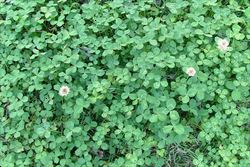
habit (Photo: Sheldon Navie)
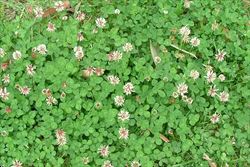
habit in flower (Photo: Sheldon Navie)

habit in fruit (Photo: Sheldon Navie)
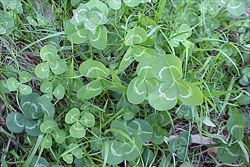
leaves with paler v-shaped markings (Photo: Sheldon Navie)
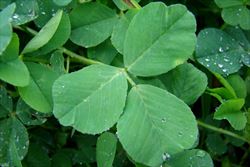
close-up of leaf with three leaflets (Photo: Forest and Kim Starr, USGS)

close-up of leaflets with finely-toothed margins (Photo: Greg Jordan)

flower clusters (Photo: Sheldon Navie)
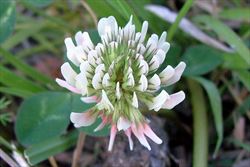
close-up of whitish flowers (Photo: Sheldon Navie)

close-up of pinkish flowers (Photo: Forest and Kim Starr, USGS)
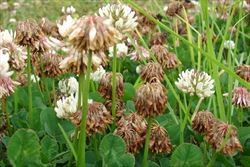
clusters of mature fruit (Photo: Forest and Kim Starr, USGS)

close-up of old flowers containing mature fruit (Photo: Sheldon Navie)
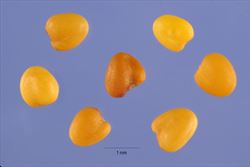
close-up of seeds (Photo: Steve Hurst at USDA PLANTS Database)

comparison of white clover (Trifolium repens), mostly on the right, and strawberry clover (Trifolium fragiferum), mostly on the left (Photo: Sheldon Navie)
Scientific Name
Trifolium repens L.
Synonyms
Trifolium repens L. var. repens
Family
Fabaceae (Queensland, the ACT, Victoria, Tasmania, and the Northern Territory)Fabaceae: sub-family Faboideae (New South Wales)Leguminosae (South Australia)Papilionaceae (Western Australia)
Common Names
clover, Dutch clover, honeysuckle clover, ladino clover, purplewort, shamrock, white clover, white Dutch clover, white trefoil
Origin
Native to northern Africa, Europe, the middle-east, western Asia, Russia and Pakistan.
Cultivation
White clover (Trifolium repens) is commonly cultivated as a pasture legume, particularly in the cooler parts of Australia.
Naturalised Distribution
This species is common and widespread throughout the southern and eastern parts of Australia. It is most commonly naturalised in Victoria, the ACT, eastern New South Wales, Tasmania, south-eastern South Australia and south-eastern Queensland. Also less common in south-western Western Australia, present in other parts of Queensland, and naturalised on Lord Howe Island.
Widely naturalised overseas, including in southern Africa, tropical and eastern Asia, New Zealand, North America (i.e. the USA and Canada), Mexico, Central America, the Caribbean, South America and Hawaii.
Habitat
A very common and widespread weed of lawns, parks, gardens, roadsides, waste areas, disturbed sites, riparian vegetation, grasslands, open woodlands and alpine vegetation. It mainly grows in temperate and sub-tropical regions, where it is most abundant during winter and spring. However, it is sometimes found growing in tropical regions and is also an occasional weed of crops.
Habit
A short-lived (i.e. annual) or long-lived (i.e. perennial) herbaceous plant with creeping (i.e. prostrate) stems, and upright flower stalks 10-30 cm tall.
Distinguishing Features
- a creeping herbaceous plant that is mostly encountered during winter and spring.
- its compound leaves have three leaflets, often with distinctive paler v-shaped markings.
- its small, white or pinkish, pea-shaped flowers are borne in dense globular clusters at the top of slender upright stalks.
- its tiny pods remain hidden inside the old flower parts.
Stems and Leaves
The creeping stems (i.e. stolons) grow very close to ground level and produce roots (i.e. adventitious roots) at their joints (i.e. nodes). They are mostly hairless (i.e. glabrous or glabrescent) and are usually less than 30 cm long.
The alternately arranged leaves are hairless (i.e. glabrous) and borne on long stalks (i.e. petioles) that tend to curve upwards. These leaves are compound and consist of three leaflets (i.e. they are trifoliate). The individual leaflets (10-55 mm long and 6-30 mm wide) are either oval (i.e. elliptic), egg-shaped in outline (i.e. obovate), or heart-shaped (i.e. obcordate) and have finely-toothed (i.e. serrate or dentate) margins. They usually have distinctive paler green v-shaped markings on their upper surfaces and their tips are either rounded or notched (i.e. they have obtuse, retuse or emarginate apices).
Flowers and Fruit
The small pea-shaped flowers are white to pale pink and arranged in dense globular clusters (15-35 mm across) at the top of long upright stalks (i.e. erect peduncles). Each of the flowers is borne on a short stalk (i.e. pedicel) 3-5 mm long and has five green or reddish sepals, which are fused together into a small tube (i.e. calyx tube). They also have five petals (4-13 mm long): a large upper petal (i.e. standard), two side petals (i.e. wings) and two lower petals that are fused together and folded (i.e. they form a keel). Each flower also has ten tiny stamens and an ovary topped with a style and stigma. Flowering occurs mostly during spring and early summer.
The tiny pods (4-6 mm long and up to 2 mm wide) remain hidden inside the old flower parts. Each of these inconspicuous fruit contains three or four seeds.
Reproduction and Dispersal
This species reproduces by seed and vegetatively via its creeping stems (i.e. stolons).
Environmental Impact
White clover (Trifolium repens) is regarded as an environmental weed in Victoria, New South Wales and Western Australia. It is most problematic in the sub-alpine regions of south-eastern Australia, including Kosciusko National Park, and in some areas it threatens endangered species and native plant communities.
Legislation
Not declared or considered noxious by any state government authorities.
Similar Species
White clover (Trifolium repens) may be confused with strawberry clover (Trifolium fragiferum), subterranean clover (Trifolium subterraneum), clustered clover (Trifolium glomeratum) and woolly clover (Trifolium tomentosum). These species can be distinguished by the following differences:
- white clover (Trifolium repens) has hairless (i.e. glabrous) stems and leaves. Its white or pinkish-coloured flowers are arranged in globular clusters containing numerous flowers. These clusters are borne on long stalks in the leaf forks (i.e. axils). Its fruit remain enclosed in the dried brownish-coloured flower parts at maturity.
- strawberry clover (Trifolium fragiferum) has somewhat hairy (i.e. pubescent) stems and leaves. Its pinkish or whitish-coloured flowers are arranged in globular clusters containing numerous flowers. These clusters are borne on long stalks in the leaf forks (i.e. axils). Its fruit remain enclosed in a slightly inflated bladder and downwards-pointing bracts at maturity.
- subterranean clover (Trifolium subterraneum) has long woolly hairs on its stems and leaves (i.e. they are pilose). Its white or occasionally pinkish-coloured flowers are arranged in few-flowered clusters. These clusters are borne on long stalks in the leaf forks (i.e. axils) and are forced downwards (i.e. become reflexed) after flowering.
- clustered clover (Trifolium glomeratum) has hairless (i.e. glabrous) stems and leaves. Its pink or whitish coloured flowers are relatively small and narrow, and are arranged in globular clusters containing numerous flowers. These clusters are stalkless (i.e. sessile) and are borne in the leaf forks (i.e. axils).
- woolly clover (Trifolium tomentosum) has hairless (i.e. glabrous) stems and leaves. Its pale pink or whitish-coloured flowers are relatively small and arranged in globular clusters containing numerous flowers. These clusters are borne on short stalks in the leaf forks (i.e. axils). Its fruit are enclosed in an inflated bladder that is usually densely covered in white-woolly hairs.

